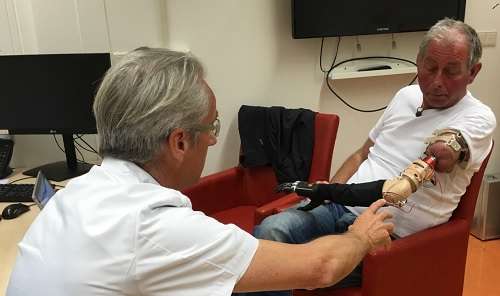Click-on robotic prosthesis interfaces with nerves

Last Friday, the first patient in the Netherlands received his click-on robotic arm. By means of a new technique, this robotic arm is clicked directly onto the bone. A unique characteristic of this prosthesis is that it can be controlled by the patient's own thoughts. Worldwide, there are only a handful of patients with such a prosthesis.
In April 2010, Johan Baggerman lost his arm in a serious accident. Seven years later, he is one of the first patients in the world with a click-on robotic arm. In the case of a click-on robotic arm, the arm prosthesis is connected directly to the arm stump. Through an opening in the skin, the patient "clicks" the prosthesis onto a metal rod in the bone. Because the prosthesis connects directly to the skeleton, a prosthesis socket is no longer necessary. This ensures that it does not slip off, avoids skin problems, and makes it very easy to put on and take off. This method has already been applied to the leg for a longer period and is now being applied for the first time in Netherlands to the arm. The main difference with the click-on leg prostheses is that the new arm prosthesis can communicate with the patient's nerves, allowing the patient to control the prosthesis with their mind.
Range of motion
Surgeon Jan Paul Frölke and rehabilitation physician Henk van de Meent introduced the click-on prosthesis in the Netherlands. They have been applying the technique to help leg amputees since 2009. From now on it is also possible for patients with an arm amputation to receive a click-on prosthesis. "All movements can be made with the shoulder," explains Henk van de Meent. "This gives the patients a larger range of motion. Another advantage is that the click-on prosthesis is attached easily and quickly." Because the innovation is still so new, the prosthesis is not yet widely available and agreements still need to be set up with health insurance companies. Eligibility is determined on a patient-to-patient basis.
Surgeries
Three surgeries are needed for the click-on arm prosthesis. During the first surgery, the surgeon inserts a metal rod into the marrow cavity of the bone. The exterior of the rod has a rough surface. This rough side is recognized and accepted by the existing bone, whereby the bone growth maximally embeds the rod. Six to eight weeks later, the second, short intervention takes place. The surgeon makes a small hole in the skin and screws a connecting rod into the rod placed earlier. This connecting rod protrudes slightly so that the prosthesis can click onto it.
The third surgery is the Targeted Muscle Reinnervation (TMR) surgery and is performed by a specialized plastic surgeon. The nerves that controlled the muscles in the hand and the underarm before the amputation are meticulously attached to parts of the muscles in the upper arm stump. By connecting the nerves to the muscle, the muscle acts like an amplifier of the nerve signal.
Controlling muscles with thoughts
The surgeries are followed by a rehabilitation period, so that the patient can learn to contract the muscles in their upper arm by using their thoughts. If the patient imagines opening and closing their hand, the muscles in the upper arm contract. The muscle activity in the upper arm is measured by Myoband which are electrodes surrounding the upper arm like a bracelet. Once the nerves have sufficiently grown into the muscle, the muscle signal is strong enough to be detected by the sensor in the Myoband and the computer in the robot arm can be controlled via Bluetooth. This is what makes movement possible.
The rehabilitation period after the TMR is very strenuous for the patient. Each day, the patients must "train" a practice hand with their mind. Once the real robotic arm is connected, this training becomes a lot easier because the movement of the hand in the patient's mind is carried out immediately by the robotic arm. The intuitive link between brain and robotic arm gives the patient the feeling that they have the same control over the arm is as if it were their own. Even after the robotic arm is connected, there is an intensive rehabilitation period during which the patient must get used to their new arm.
Timeline:
- April 28, 2010: Truck driver Johan Baggerman was involved in a serious truck accident. His arm was trapped and ultimately had to be amputated by the flight paramedic Michiel Vaneker.
- October 21, 2013: Surgery 1 by surgeon Jan Paul Frölke: the metal rod is inserted.
- January 13, 2014: Surgery 2 by surgeon Jan Paul Frölke: the connecting rod is fastened to the first rod.
- April 8, 2016: TMR surgery by plastic surgeon Erik Walbeehm: the nerves are attached to the muscles in the upper arm.
- 2016: Start of training with the practice arm under guidance of the rehabilitation physician Henk de Meent. The patient learns to contract the muscles in his upper arm with his thoughts.
- April 21, 2017: John Baggerman is the first patient in the Netherlands to receive a click-on robotic arm and starts the last part of his rehabilitation process.















